Welcome to our guide on designing with Lilaeopsis Mauritiana, an exquisite aquarium plant that adds a touch of beauty and elegance to any freshwater setup.
With its lush carpet-like appearance, this ground cover plant not only enhances the aesthetic appeal of your aquarium but also provides numerous benefits.
Whether you’re an experienced aquarist or a beginner, incorporating Lilaeopsis Mauritiana into your aquascape is a fantastic way to create a vibrant, low-maintenance underwater landscape.
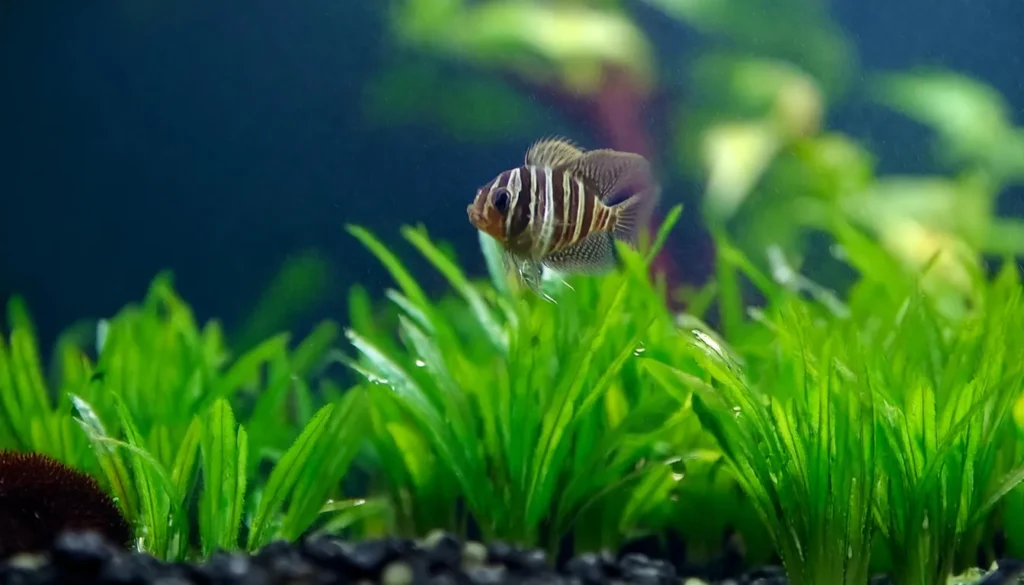
In this section, we will explore the characteristics and benefits of Lilaeopsis Mauritiana and provide valuable insights on how to incorporate it into your aquarium design.
From ideal care conditions to propagation techniques, you’ll discover everything you need to know to create a captivating aquarium with this stunning freshwater plant.
Let’s dive in and unveil the wonders of Lilaeopsis Mauritiana!
Key Takeaway
- Lilaeopsis Mauritiana is a carpeting plant that adds beauty and elegance to your aquarium.
- It is a low-maintenance freshwater plant that creates a vibrant, lush ground cover.
- You can design captivating aquascapes with Lilaeopsis Mauritiana by understanding its characteristics and care requirements.
- Propagation techniques allow you to expand your aquatic plant collection.
- With proper maintenance, Lilaeopsis Mauritiana provides a natural habitat and hiding place for other tank mates.
Quick Stats
| Attribute | Details |
| Family Name | Apiaceae |
| Origin | Mauritius |
| Height | 5-10 cm (2-4 inches) |
| pH Range | 6.0 – 7.5 |
| CO2 Requirement | Moderate |
| Growth Rate | Moderate |
| Care Level | Moderate |
| Color Form | Green |
| Water Conditions | 20-26°C (68-79°F), adaptable to a wide range of hardness |
| Max Size | Typically forms a carpet up to 10 cm (4 inches) high |
| Lighting | Moderate to High |
| Supplements | CO2 supplementation beneficial; liquid fertilizers and root tabs can enhance growth |
| Placement | Foreground |
| Propagation | By runners or dividing rhizomes |
What Is Lilaeopsis Mauritiana?
Lilaeopsis Mauritiana features thin, grass-like leaves that grow close to the substrate, creating a dense and vibrant carpet effect in the aquarium.
Its small size and compact growth habit make it an excellent choice for foreground or midground planting.
This freshwater plant is native to Mauritius and well-suited for tropical and temperate aquariums.
It thrives in various water conditions, making it relatively low-maintenance and suitable for beginners and experienced aquarists.
When provided with the appropriate care and habitat conditions, Lilaeopsis Mauritiana can spread quickly to cover large areas of the substrate, enhancing the visual appeal of the aquarium and providing a natural habitat for fish and other aquatic inhabitants.
Natural Habitat And Origin
Lilaeopsis mauritiana is native to South America, particularly Brazil and Argentina.
It is commonly found in marshes, wetlands, and along the edges of streams and rivers.
This species typically grows in moist, sandy or gravelly substrates and thrives in areas with ample sunlight.
In its natural habitat, Lilaeopsis mauritiana forms dense mats or carpets, providing habitat and shelter for small aquatic organisms.
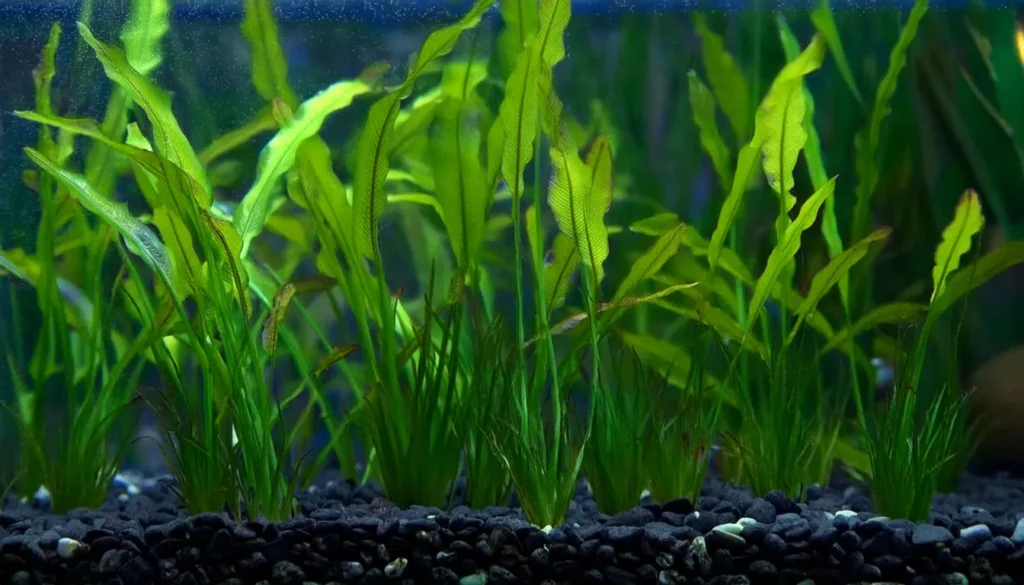
Physical Characteristics
- Leaf Structure: The leaves of Lilaeopsis mauritiana are narrow and elongated, resembling grass blades. They grow in dense clusters along runners, creating a carpet-like appearance when planted densely.
- Size: Brazilian Micro Sword typically reaches a height of 2-5 centimeters (0.8-2 inches), making it ideal for creating low-lying foreground or midground carpets in aquariums.
- Root System: Lilaeopsis mauritiana has a fibrous root system that spreads horizontally along the substrate. These roots anchor the plant securely and help it absorb nutrients from the water and substrate.
- Coloration: The leaves of Brazilian Micro Sword are typically bright green in color, adding a vibrant and lush look to aquarium landscapes. Under optimal lighting conditions, the plant may exhibit richer green hues.
Lighting Needs For The Verdant Spread
- Proper lighting is essential for the efficient photosynthesis and growth of Lilaeopsis Mauritiana. A freshwater plant requires moderate to high lighting levels to thrive. Provide a lighting setup that mimics natural daylight, with a spectrum ranging from 6500 to 10000 Kelvin.
- Avoid placing the aquarium in direct sunlight as it can lead to excessive algae growth and may harm the lilaeopsis mauritiana carpet.
- Remember to regularly monitor the lighting intensity and duration to strike a balance that promotes healthy growth without encouraging algae blooms. Adjust the lighting based on the specific needs of your aquarium setup and the growth rate of Lilaeopsis Mauritiana.
Temperature Parameters
- Lilaeopsis mauritiana, or Brazilian Micro Sword, thrives in tropical temperatures typical of its native habitat. For robust growth, maintain aquarium water temperatures within the range of 20-28°C (68-82°F). This temperature range replicates the warm conditions of its natural environment, promoting healthy growth and vitality.
- It’s essential to ensure stability in temperature to avoid stress on the plant. Using a reliable aquarium heater and monitoring water temperature regularly will help maintain optimal conditions for Brazilian Micro Sword in your aquarium.
Optimal Water Condition
- pH: Brazilian Micro Sword thrives in slightly acidic to neutral pH levels, ideally between 6.5 and 7.5. Maintain a stable pH within this range to support healthy growth and nutrient uptake.
- Water Hardness: This plant prefers soft to moderately hard water with a general hardness (GH) between 3 to 8 dGH (degrees of general hardness). Ensuring appropriate water hardness levels helps prevent nutrient deficiencies and promotes robust growth.
- Temperature: Maintain aquarium water temperatures within the range of 20-28°C (68-82°F) for Brazilian Micro Sword. This temperature range replicates the warm, tropical conditions of its native habitat and supports optimal growth and vitality.
- Nutrients: Brazilian Micro Sword benefits from a nutrient-rich substrate and regular fertilization. Use a high-quality aquarium substrate rich in nutrients, or supplement with root tabs or liquid fertilizers containing essential nutrients such as nitrogen, phosphorus, and potassium. Ensure that nutrient levels remain balanced to prevent deficiencies or algae overgrowth.
- Water Movement: Moderate water circulation is beneficial for Lilaeopsis mauritiana, as it helps distribute nutrients and oxygen throughout the aquarium. Avoid excessive water movement, which can uproot or damage the delicate roots of the plant.
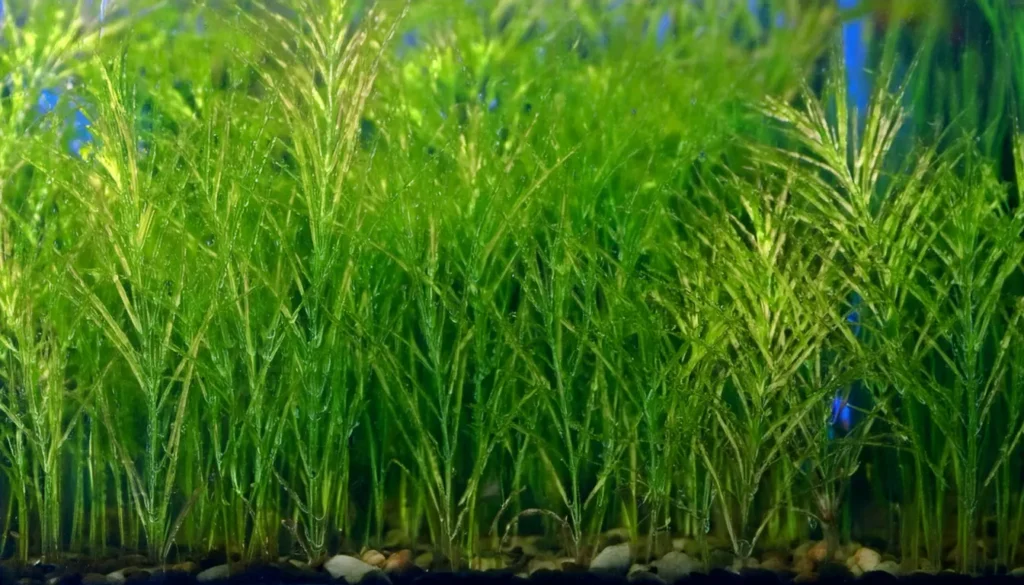
The Best Substrate For Root Health
- The choice of substrate is crucial for the root health and growth of Lilaeopsis Mauritiana. This carpeting plant requires a fine-grained substrate that allows its roots to spread and anchor effectively. A nutrient-rich substrate, such as an aquasoil or a specialized aquarium plant substrate, will provide the necessary nutrients for sustained growth.
- It is also important to ensure that the substrate is compact and doesn’t have large gaps or loose particles that may disrupt the plant’s anchorage. Selecting the right substrate provides a solid foundation for the Lilaeopsis Mauritiana carpet to flourish.
Placement Option
- Foreground: Brazilian Micro Sword is commonly used as a foreground plant due to its low-growing and carpeting nature. Planting it in the foreground of your aquarium creates a lush carpet effect that adds depth and visual interest to the layout. Arrange the plants in clusters or rows along the front glass of the aquarium to create a cohesive and uniform look.
- Midground: While Brazilian Micro Sword is often used as a foreground plant, it can also be placed in the midground of the aquarium, especially in larger tanks. Planting it in the midground adds texture and fills in empty spaces between taller background plants and hardscape features. This placement option helps create a balanced and harmonious aquascape.
- Between Hardscape: Integrate Brazilian Micro Sword between hardscape elements such as rocks, driftwood, or decorative stones to create a natural transition between the foreground and background. Planting it around or between hardscape features adds depth and dimension to the aquarium layout while softening the hardscape’s edges.
- Aquascaping Features: Incorporate Brazilian Micro Sword into aquascaping features such as terraces, slopes, or raised areas to create visual interest and contouring within the aquarium. Use the plants to define borders or highlight focal points, such as rock formations or caves, enhancing the overall aesthetics of the aquascape.
Recommended Tank Size
The recommended tank size for Lilaeopsis mauritiana, or Brazilian Micro Sword, depends on various factors including the desired aquascape layout, tank dimensions, and the needs of other tank inhabitants.
However, for optimal growth and aesthetic appeal, a tank size of at least 10 gallons (approximately 38 liters) or larger is recommended.
In larger tanks, Brazilian Micro Sword can be planted more extensively to create lush carpets or fill in foreground and midground areas effectively.
Additionally, larger tanks provide more space for the plant to spread and form dense mats, enhancing the overall visual impact of the aquascape.
It’s important to consider the dimensions and footprint of the tank when planning the placement of Brazilian Micro Sword.
A wider tank provides more surface area for planting and allows for greater creativity in aquascaping.
However, even in smaller tanks, Brazilian Micro Sword can still be used to create beautiful foreground carpets or accentuate specific areas of the aquascape.
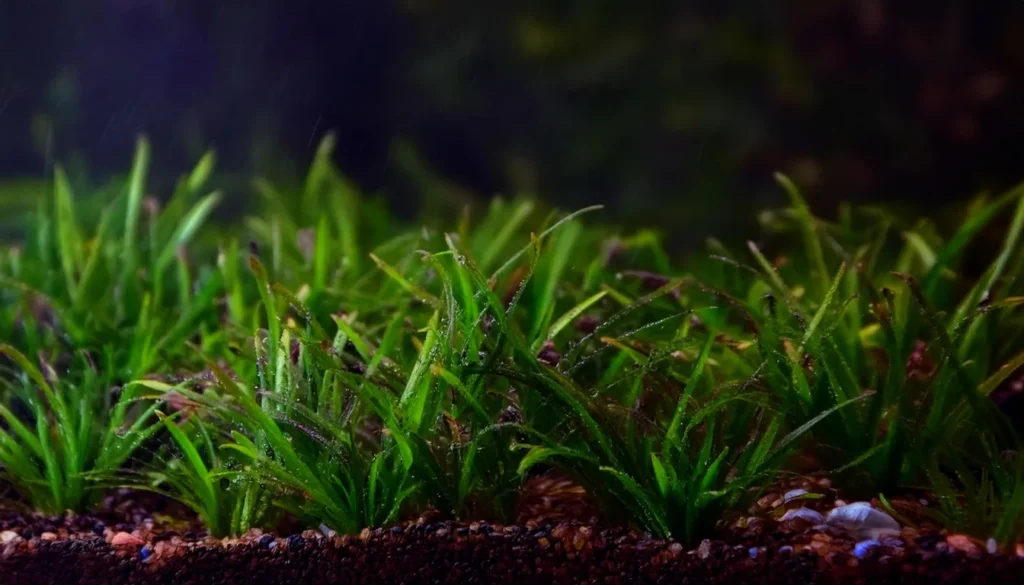
Lilaeopsis Mauritiana And Tank Mates: A Symbiotic Relationship
- Lilaeopsis Mauritiana is a natural habitat and hiding place for smaller fish and invertebrates. Its dense carpet-like growth creates a protective environment, providing shelter and security for vulnerable species. The plant acts as a refuge, helping to reduce stress and promote natural behaviors among tank mates.
- Additionally, the dense matting of Lilaeopsis Mauritiana’s foliage serves as a filtration system, aiding in water purification by trapping debris and excess nutrients. This benefits the plant and the tank mates by creating a healthier and cleaner living environment.
- When choosing tank mates for your Lilaeopsis Mauritiana, it is important to consider their water requirements and behavior compatibility. The plant thrives in freshwater conditions with moderate to high lighting levels, so ensure that the chosen tank mates share similar water parameter preferences.
Here are some compatible tank mates that can thrive alongside Lilaeopsis Mauritiana:
- Neon Tetras
- Otocinclus Catfish
- Cherry Shrimp
- Dwarf Gouramis
- Amano Shrimp
| Tank Mate | Water Preference | Behavior |
| Neon Tetras | Soft, slightly acidic water | Peaceful, schooling behavior |
| Otocinclus Catfish | Soft, slightly acidic water | Peaceful, algae-eating behavior |
| Cherry Shrimp | Neutral to slightly alkaline water | Peaceful, scavenging behavior |
| Dwarf Gouramis | Soft, slightly acidic water | Peaceful, colorful and active behavior |
| Amano Shrimp | Neutral to slightly alkaline water | Peaceful, algae-eating behavior |
RELATED: Exploring Beauty And Versatility Of Anubias Nangi In Aquascapes
Nutritional Needs Of The Plant
- Substrate Nutrients: Brazilian Micro Sword benefits from a nutrient-rich substrate. A substrate specifically designed for planted aquariums or enriched with nutrients such as iron, potassium, and trace elements will provide essential nutrients for root uptake.
- Liquid Fertilization: While Brazilian Micro Sword primarily absorbs nutrients through its roots, supplementing with liquid fertilizers can provide additional nutrients, especially for plants with high growth rates. Choose a comprehensive liquid fertilizer formulated for aquarium plants and dose according to the manufacturer’s instructions.
- Planting Density: Plant Brazilian Micro Sword densely to encourage the formation of a lush carpet effect. Space individual plants about 1-2 inches apart to allow them to spread and fill in empty spaces over time.
- Light: Adequate lighting is essential for Brazilian Micro Sword to carry out photosynthesis effectively. Provide moderate to high-intensity lighting with a spectrum suitable for plant growth. Ensure consistent lighting duration of 8-10 hours per day to maintain healthy growth patterns.
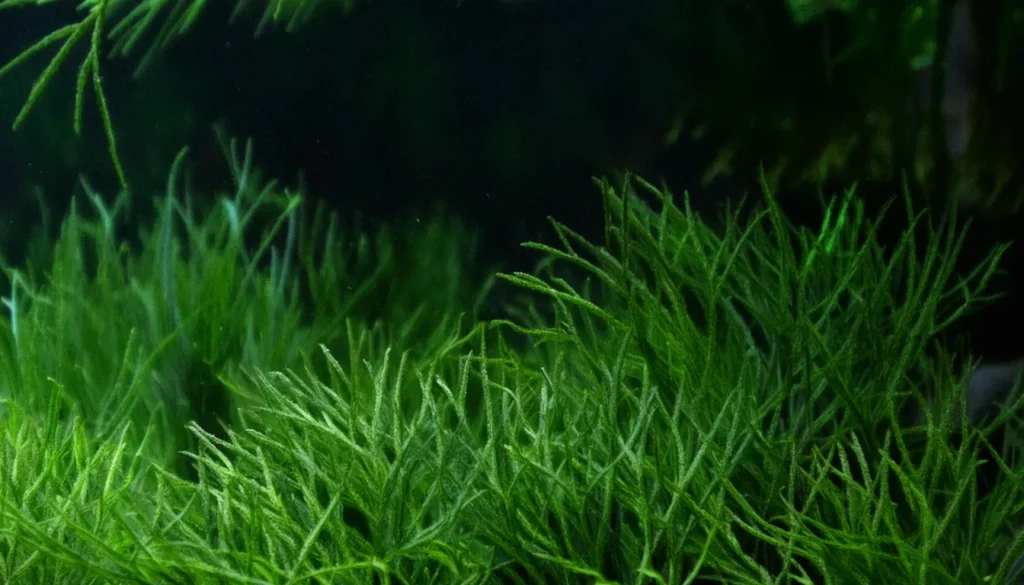
Lilaeopsis Mauritiana Cultivation Tips
- Substrate: Use a nutrient-rich substrate suitable for planted aquariums. Choose a fine-grained substrate like sand or aquarium soil to anchor the delicate roots of Brazilian Micro Sword securely.
- Lighting: Provide moderate to high-intensity lighting to support photosynthesis and promote healthy growth. Full-spectrum LED lights or fluorescent bulbs with a color temperature between 5000K and 7000K are ideal for Brazilian Micro Sword.
- Carbon Dioxide (CO2): While not mandatory, supplementing with CO2 can enhance growth and promote lush foliage in Brazilian Micro Sword. Consider injecting CO2 into the aquarium, especially in high-tech setups with high light and nutrient levels.
- Water Parameters: Maintain optimal water parameters, including slightly acidic to neutral pH (6.5-7.5), soft to moderately hard water, and temperatures between 20-28°C (68-82°F). Consistent water quality helps support nutrient uptake and overall plant health.
Plant Propagation Tips
- Runners: Brazilian Micro Sword produces runners that spread horizontally across the substrate. These runners develop new plantlets along their length, which can be separated and replanted to propagate the plant. Allow the runners to grow and develop plantlets before carefully cutting them away from the parent plant with sharp scissors or aquascaping tools. Replant the separated plantlets in desired areas of the aquarium to encourage new growth.
- Division: Another method of propagation involves dividing mature clumps of Brazilian Micro Sword into smaller sections. Carefully remove the plant from the substrate and gently separate it into smaller portions, ensuring that each section has healthy roots attached. Replant the divided sections in the substrate, spacing them apart to allow for growth and expansion.
- Trimming and Replanting: Regularly trimming Brazilian Micro Sword helps promote new growth and prevents overcrowding. Trim overgrown or damaged leaves with sharp scissors, making clean cuts close to the base of the plant. Replant the trimmed sections in the substrate to encourage new root development and continued growth.
Benefits Of Planting Lilaeopsis Mauritiana
- Naturalistic Appearance: Brazilian Micro Sword forms dense carpets of grass-like foliage, creating a lush and naturalistic appearance in the aquarium. Its low-growing habit makes it an ideal choice for foreground or midground planting, adding depth and visual interest to the aquascape.
- Oxygenation: Like all aquatic plants, Brazilian Micro Sword contributes to oxygenation in the aquarium through photosynthesis. It absorbs carbon dioxide and releases oxygen, helping to maintain optimal water quality and support the health of fish and other aquatic inhabitants.
- Nitrate Uptake: Brazilian Micro Sword absorbs nutrients such as nitrates from the water column, helping to reduce nutrient levels and prevent algae overgrowth. By incorporating this plant into the aquarium, you can promote a healthier balance of nutrients and minimize the risk of algae outbreaks.
- Habitat for Fish and Invertebrates: The dense carpeting provided by Brazilian Micro Sword offers shelter and spawning sites for small fish, shrimp, and other aquarium inhabitants. It creates a natural habitat that mimics the plants’ native environment, promoting the well-being and natural behaviors of aquatic species.
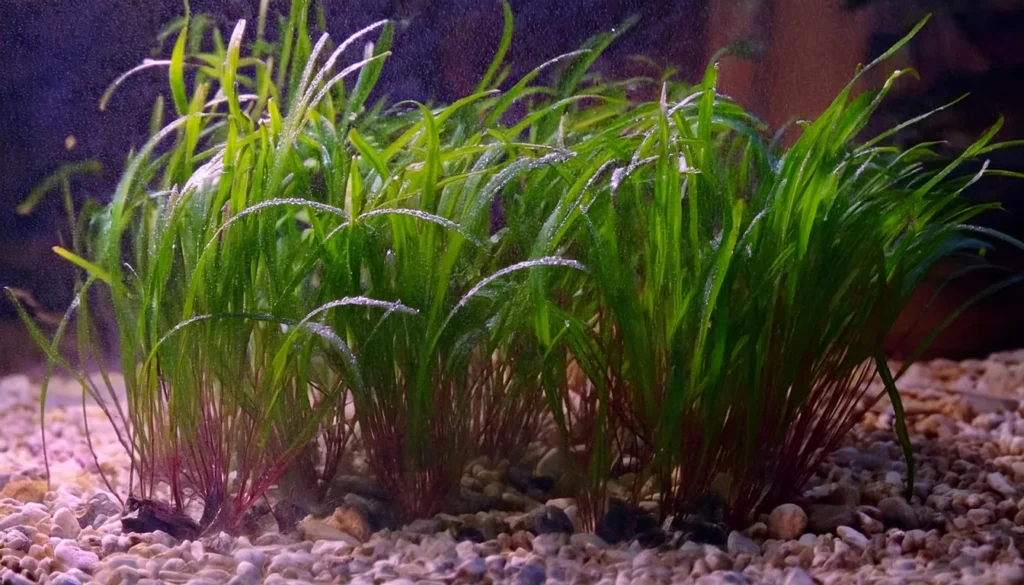
Common Challenges And Solutions With Lilaeopsis Mauritiana
Addressing Yellowing Leaves
- Ensure your Lilaeopsis Mauritiana receives sufficient light. Consider investing in a high-quality aquarium light or adjusting the placement of existing lighting to provide the necessary intensity for plant growth.
- Regularly check and maintain water parameters such as pH, hardness, and nutrient levels. Test your water and make any necessary adjustments to provide optimal conditions for your aquatic plants.
- Consider adding liquid fertilizers or root tabs specifically formulated for aquarium plants. These can help provide essential nutrients, especially if your aquarium’s substrate lacks nutritional value.
- Promote water circulation to optimize the growth environment. A well-placed aquarium filter or a gentle air pump can prevent stagnant water and promote overall plant health.
Preventing And Treating Root Rot
- Ensure adequate water flow in your aquarium to prevent the buildup of stagnant water around the plant’s roots. This can be achieved using a filter or strategically positioning your aquarium’s outlet.
- Avoid overcrowding your aquarium with too many plants. This can lead to limited oxygen availability and increased moisture levels, creating an environment conducive to root rot.
- Take immediate action if you notice signs of root rot, such as brown, mushy roots. Trim the damaged roots and replant the healthy sections to remove the affected portions of the plant.

Conclusion
After delving into the world of Lilaeopsis Mauritiana, it is clear that this aquatic plant is a versatile and stunning addition to any freshwater aquarium.
Its carpet-like growth and low-maintenance nature make it an ideal choice for both beginner and experienced aquarists.
Incorporating Lilaeopsis Mauritiana into your aquascape enhances the aesthetic appeal and provides a natural habitat and hiding place for your tank mates.
This plant’s ability to create a verdant spread and form a lush ground cover adds depth and visual interest to your aquarium.
By ensuring optimal water conditions, choosing the right substrate, and providing adequate lighting, you can ensure the healthy growth of Lilaeopsis Mauritiana in your aquarium.
Regular maintenance, such as trimming, managing algae, and balancing nutrition through fertilizers and CO2 supplementation, will contribute to its long-term health and vibrancy.
We discussed the various propagation methods to expand your aquatic plant collection, including splitting runners and harvesting new shoots.
Proper care and propagation techniques can increase your Lilaeopsis Mauritiana population and create even more stunning aquascapes.
Frequently Asked Questions
How Do I Maintain Lilaeopsis Mauritiana For Optimal Health?
Regular trimming is essential to maintain a manicured look and prevent overgrowth.
Algae can be managed by maintaining good water quality and providing proper nutrient balance.
Fertilizers and CO2 supplementation can ensure proper nutrition for healthy growth.
Is Lilaeopsis Mauritiana Compatible With Other Species In The Aquarium?
Lilaeopsis Mauritiana is a habitat and hiding place for tank mates, fostering a symbiotic relationship.
It provides shelter and protection, making it compatible with many species of fish and invertebrates.
How Can I Propagate Lilaeopsis Mauritiana To Expand My Plant Collection?
Lilaeopsis Mauritiana can be propagated by splitting its runners and replanting them in suitable areas.
The best time to harvest new shoots for successful propagation is when they have developed a sufficient root system.
How Can I Incorporate Lilaeopsis Mauritiana Into My Aquascape Design?
Lilaeopsis Mauritiana can be used to create stunning visual compositions in your aquascape.
It can be arranged in different patterns, such as creating pathways or undulating hills, to add depth and texture to your aquarium design.
What Are Some Common Challenges That May Arise When Caring For Lilaeopsis Mauritiana?
Yellowing leaves can indicate nutrient deficiencies or inadequate lighting.
Root rot can occur if the substrate is too compacted or if there is insufficient water circulation around the roots.
- Unveiling The Wonders Of Riccia Fluitans In Aquascapes - August 7, 2024
- Vallisneria Gigantea Var. Guide To Care And Cultivation At Home - July 31, 2024
- Vesicularia Dubyana Care & Growth Guide Tips For Beginner Gardeners - July 30, 2024
